“For which one of you, when he wants to build a tower, does not first sit down and calculate the cost to see if he has enough to complete it?”
Luke 14:28 (NASB)
“You can use an eraser on the drafting table or a sledgehammer on the construction site.”
Frank Lloyd Wright
Discover the purpose of your work and your corporation
What is your purpose in work?
- You can help to facilitate the production and distribution of goods and services for the social and economic deprived population in Borneo.
- Your investment in the basic infrastructure projects will improve the living conditions of the frontier communities.
What drives your corporation’s core value?
- Provide the basic interconnectivity and platforms for economic growth and social benefits to the developing nations.
- Generate a stable income for the company.
Infrastructure Borneo
North Borneo Railway Balikpapan Bay 1905-1914 Tawau Old Airport
1898
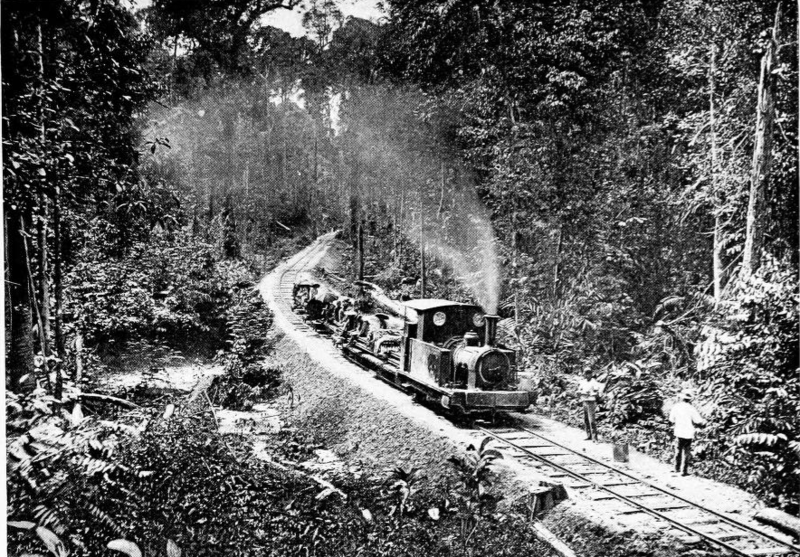
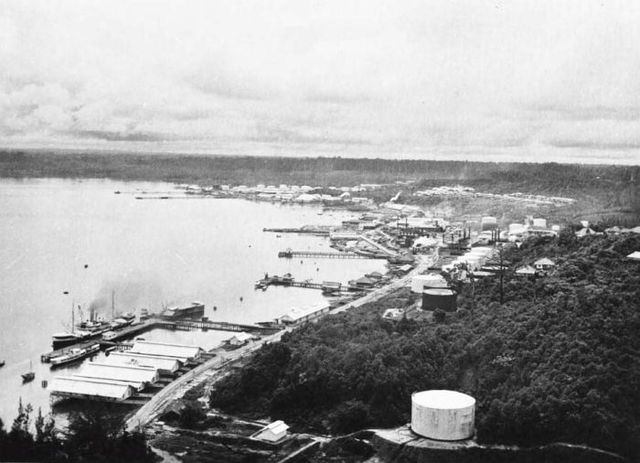
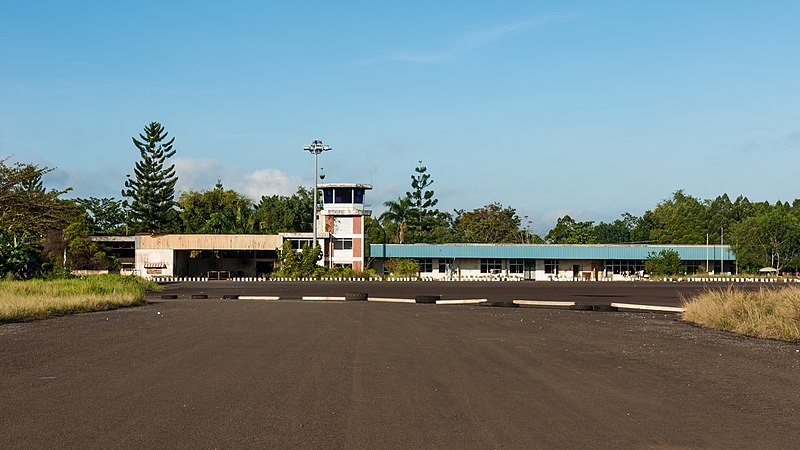
Brunei Industrial SEZ Roadway in Sabah by RAE
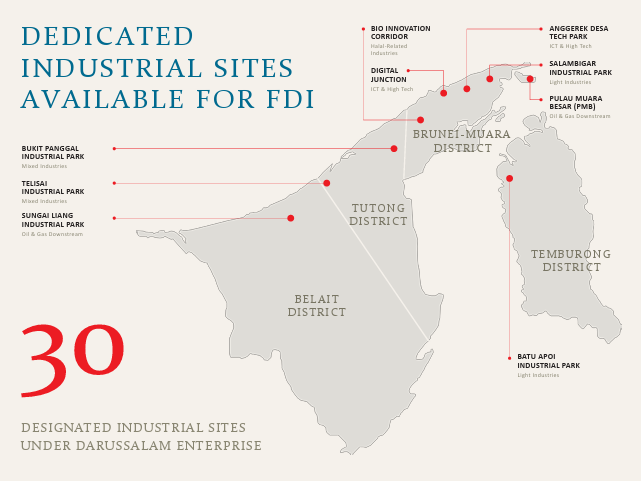

1.0 Executive Summary
Mission
The mission is to establish strategic alliances with public sectors, foreign investors, international infrastructure contractors, and operators. Form new construction Public-Private Partnership (PPP) entities, strategically targeting specific infrastructure projects to capture low-hanging fruits in the industry.
Key Management Team
- Mentors: Visionary pioneers and industry leaders who provide guidance and inspiration.
- Coaches: Mission-oriented industry experts offering practical solutions.
- Partners:
- A project leadership group with experience in the specific segment and international exposure to the infrastructure construction industry.
- A reputable investment manager with sources of funding in the Asia Pacific infrastructure industry.
- Target market groups comprising government agencies.
- A credible local infrastructure partner with procurement capabilities, local network, sound financial status and solid support from the government.
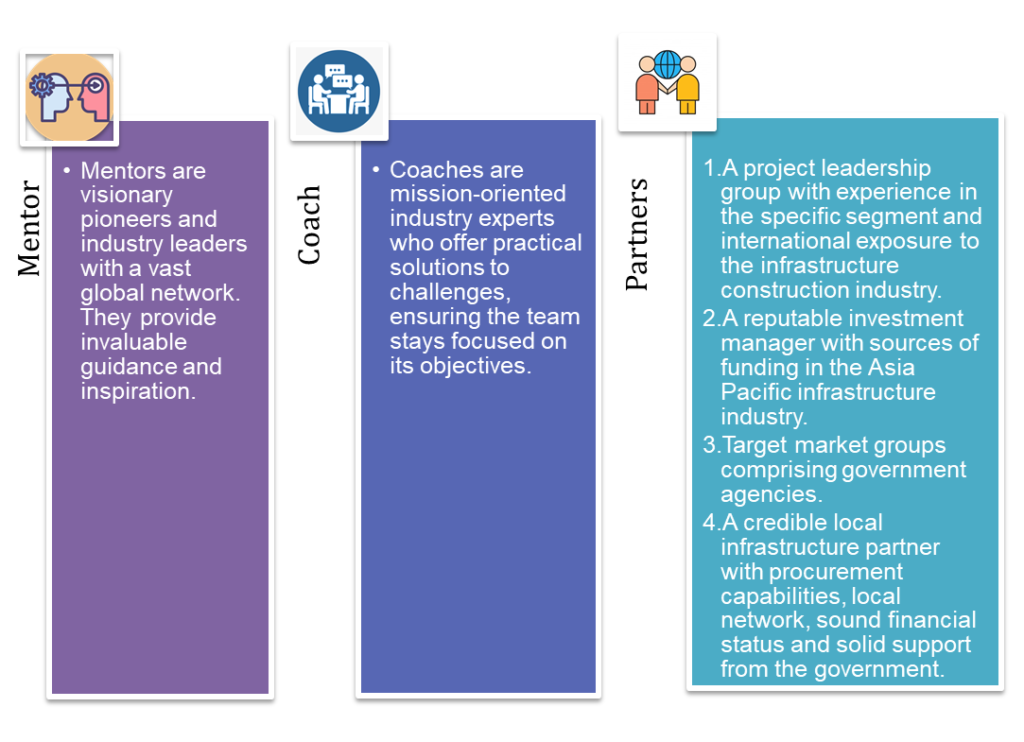
Product Benefits
- Profit: Transparent cost and profit sharing structure.
- Culture: Promoting diverse culture and social integration among team members.
- Training: Transferring international expertise to local teams.
- Return: Offering long-term, stable yield, reliable returns, and inflation protection.

Target Market
- Segment: Focusing on mass transit rail, highway, airport, seaport, water supply, and special economic zone (SEZ) infrastructure construction segments.
- Customers: Government agencies in Borneo seeking infrastructure development.
Financial Projections
- Investment: 6 segments = US$86.7 billion
- Cost: 6 segments = US$78.03 billion
- Profit: 6 segments = US$8.67 billion
- Payback: 3 -12 years (depending on scope and segment)
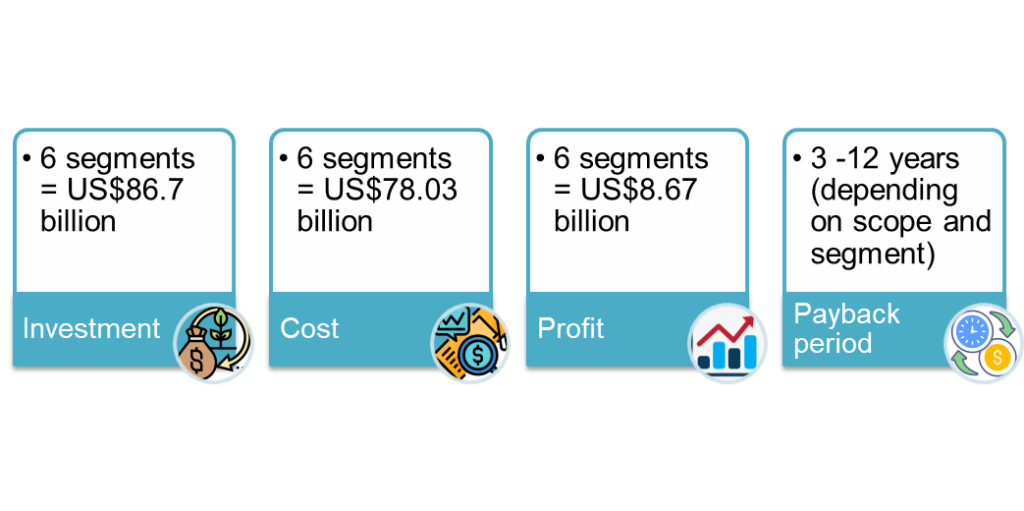
Unique Business Model
- PPP Model: Leveraging the Public-Private Partnership model for infrastructure development.
- Goals: Ensuring successful track records of global infrastructure companies to guarantee project timelines, quality, and financial objectives.
- Return: Targeting specific sectors to meet financial goals.
- Growth: Expanding into other infrastructure projects in Borneo.
- Support: Expecting solid support from local government agencies.
- Community: Enriching local communities through employment and on-the-job training programs.
2.0 Mission
2.1 Problem
- Skill: The infrastructure and construction industry in Borneo faces challenges related to advanced management practices, skill shortages, low productivity, outdated technology, and inadequate corporate governance.
- Growth: The global infrastructure construction industry confronts issues such as competitive cost pressures, narrow profit margins, and sluggish growth prospects.
- Investment: Borneo’s infrastructure construction sector suffers from a lack of funding and viable foreign investors, hindering its development potential.
2.2 Solution:
- PPP: Addressing these challenges requires a collaborative approach through Public-Private Partnerships (PPP) for infrastructure planning, funding, construction, and operation.
- Team: To ensure the success of PPP initiatives, government support and foreign investors will be essential to provide the necessary cash flow, equity, and long-term commitment. Additionally, involving international contractors at the planning stage can help reduce delays and the risk of project defaults.
2.3 Mission:
- Entity: The mission is to establish strategic alliances with public sectors, foreign investors, international infrastructure contractors, and operators to address the infrastructure challenges in Borneo.
- Segment: Form new construction PPP entities targeting specific infrastructure segments in Borneo, including:
- Mass Transit Rail: Estimated at US$10.1 billion
- Highway: Estimated at US$30.8 billion
- Airports: Estimated at US$1.0 billion
- Seaports: Estimated at US$13.0 billion
- Water Supply: Estimated at US$19.8 billion
- Special Economic Zones (SEZ): Estimated at US$12.0 billion
- Total Investment: US$86.7 billion
3.0 Product
3.1 Product Description
The infrastructure construction projects serve as the cornerstone of economic growth, providing vital transportation links and services for both people and goods. These projects are meticulously planned, financed, and executed through the collaborative efforts of an international and local team of infrastructure specialists. Our business model is centred around the establishment of Public-Private Partnership (PPP) entities.
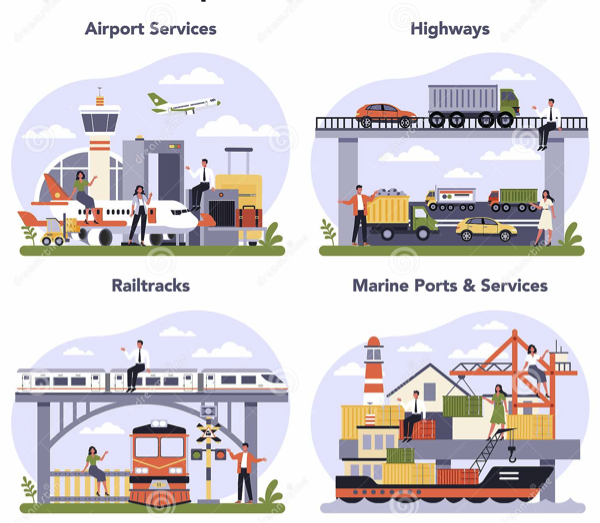
3.2 Product Attributes
Infrastructure construction projects exhibit the following key characteristics:
- PPP: They involve a joint investment from public and private partners.
- Capital: These projects are capital-intensive, requiring substantial financial resources.
- Occurrence: Typically, they are one-off projects, each with unique requirements.
- Program: Projects are completed within specified timeframes, quality standards, and budgetary constraints, with contractual commitments in place.
- Effect: The assets created facilitate long-term services and benefits for the community and stakeholders.
3.3 Product Benefits:
- Profit: A transparent cost and profit-sharing structure ensures fairness and accountability.
- Culture: Encouraging diverse cultures and promoting social integration among team members.
- Training: Providing an opportunity to transfer international expertise to local teams, enhancing skills and knowledge.
- Return: Offering long-term, stable yields, reliable returns, and protection against inflation.
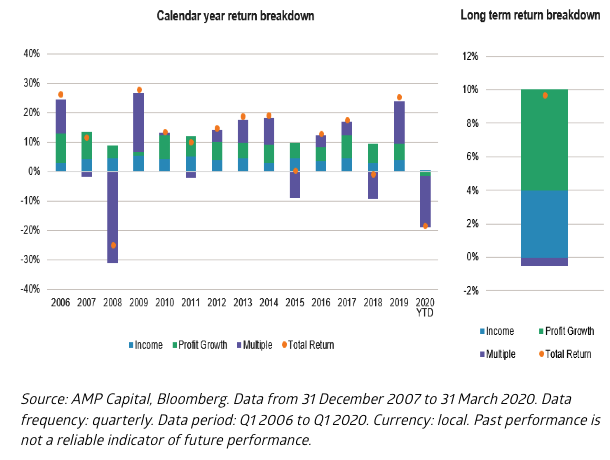
3.4 Product Competitive Advantages:
- Team: Top management teams with successful track records in infrastructure development, ensuring effective project execution.
- Risks: Contractual terms, including risk mitigation strategies, are established during the planning stage, ensuring project success and financial returns.
- Ethics: Implement transparency and robust corporate governance, reducing the risk of corruption and disruptions caused by political changes.
4.0 Market
4.1 Market Segments
- The specific infrastructure construction segments:
- Mass transit rail
- Highway
- Airport
- Seaport
- Water supply
- special economic zone (SEZ)

4.2 Target Market Segment Strategy
The strategy is based on three questions:
- Is there a need?
- Is it financially viable?
- Is it deliverable?
Need: Identify and target segments within the construction industry that show strong growth potential. Among these, the infrastructure sector is the fastest-growing, and within it, mass transit rail, highway, airport, seaport, water supply, and SEZ projects offer significant opportunities for employment and economic growth in the region.

Return: Infrastructure investors seek stable and long-term financial returns. The strategy is to ensure the bankability of the projects through factors such as turnover sales, product usage, and a unique business model that generates the expected financial returns. Public-Private Partnerships (PPP) are a key strategy in this regard.
An example of listed infrastructure versus global equities

https://www2.asx.com.au/blog/benefits-of-infrastructure-investing
Team: Top international infrastructure construction specialists will ensure projects are completed on time, within budget, and with the specified quality standards. Their expertise is a key success factor in delivering the projects.
4.3 Market needs
Indonesia
The Indonesia government has allocated US$287 billion for infrastructure projects from 2020 to 2024. Investment breakdown will be:
Government = 40%.
State-owned enterprise = 25%.
Private sector = 35%.
Investment segment
Transportation sector = 60%
Energy = 17%
Irrigation = 10%
Information Communication = 8%
Water supply and sanitation = 5%
In May 2020, the Indonesian Government has announced there will be 89 new infrastructure projects valued at US$97 billion, besides the existing 223 national strategic projects.
The 89 new projects comprised: Road and bridge projects = 15 Dams and irrigation systems = 13 Border infrastructure projects = 13 Energy projects = 12 Railway projects = 6 Clean water projects = 6 Airports = 5 Seaports = 5 Industrial zones = 5 Technology projects = 3 Smelters = 3 Seawall = 1 Waste management = 1 Land procurement = 1
Malaysia
- Pan Borneo Highway (Malaysia): In 2020, the Malaysian Government allocated a substantial budget of US$7 billion for the Pan Borneo Highway. This highway project is crucial as it aims to improve the road infrastructure across the island of Borneo, connecting the Malaysian states of Sabah and Sarawak. The highway is expected to enhance transportation links, promote economic development, and facilitate smoother movement of goods and people within Borneo.
- Sarawak Infrastructure Projects: The Sarawak government’s allocation of US$1.1 billion for infrastructure projects underscores its commitment to advancing development in the region. Sarawak is one of the Malaysian states on the island of Borneo and has been actively investing in infrastructure to boost economic growth and improve the quality of life for its residents.
- North Eastern Sabah Railway Line: The proposed North Eastern Sabah Railway Line is a significant transportation initiative for the state of Sabah in Malaysia. This railway line is intended to connect major cities like Kota Kinabalu, Kudat, Sandakan, and Tawau. The project is expected to enhance transportation connectivity within Sabah and promote economic development by facilitating the movement of goods and people. Additionally, the vision of linking the rail networks of Sabah and Sarawak to the provinces of Kalimantan in Indonesia to form the greater Trans-Borneo Railway holds the potential to greatly enhance regional integration and trade.
Brunei
Brunei Government plans to expand its investment in the oil and gas downstream industry.
4.4 Growth Drivers:
Several factors are driving growth in the infrastructure construction market, including population growth, increased foreign investment in SEZ hubs, and urbanization with rural-to-urban labour migration.
4.5 Key Customers
1. Mass Transit Rail:
- Kementerian Perhubungan (Ministry of Transportation), PT Kereta Api Indonesia
- Jabatan Keretapi Negeri Sabah (Ministry of Infrastructure Development), Sabah State Rail
2. Highway: Pan Borneo Highway
- Kementerian Pembangunan (Ministry of Development) Brunei
- Kementerian Pekerjaan Umum dan Perumahan Rakyat (Ministry of Public Works and Housing) Indonesia
- Kementerian Kerja Raya (Minister of Works) Malaysia
3. Airport:
- Kementerian Pengangkutan Malaysia (Ministry Of Transport), Malaysia Airports Holdings Berhad
4. Seaport:
- Ministry of Transport, Maritime and Port Authority of Brunei
- Kementerian Perhubungan (Ministry of Transportation) Indonesia, PT Pelabuhan Indonesia II (Persero)
- Ministry of Infrastructure and Port Development Sarawak
- Jabatan Keretapi Negeri Sabah (Ministry of Infrastructure Development Sabah)
5. Water supply:
- Kementerian Pembangunan (Ministry of Development) Brunei
- Kementerian Pekerjaan Umum dan Perumahan Rakyat (Ministry of Public Works and Housing), Kementerian Kesehatan (Ministry of Health), Perusahaan Daerah Air Minum (Regional Water Company) Indonesia
- Jabatan Air Negeri Sabah (Sabah State Water Department)
- Kementerian Utiliti Sarawak, (Ministry of Utilities) Sarawak
6. Special Economic Zone:
- Kementerian Kewangan dan Ekonomi (Ministry of Finance and Economy) Brunei
- Kementerian Keuangan (Ministry of Finance), Dewan Nasional Kawasan Ekonomi Khusus (National Council For Special Economic Zone) Indonesia
- Sarawak Corridor of Renewable Energy (SCORE) Regional Corridors Development Authority.
- Sabah Development Corridor (SDC), Sabah Economic Development and Investment Authority (SEDIA)
Proposed Indonesia New Capital – Nusantara

4.6 Competition and Industry
Key players in the infrastructure construction industry:
Global: Actividades de Construcción y Servicios (ACS): A Spanish-based construction and engineering company with a global presence, ACS is involved in various infrastructure sectors, including transportation, energy, and civil engineering. Balfour Beatty: A UK-based multinational construction and infrastructure company with a strong focus on projects related to transportation, power, and utilities. Bechtel: Bechtel is one of the largest engineering, construction, and project management companies globally, known for its involvement in complex infrastructure projects, including energy, transportation, and civil engineering. Bouygues: A French conglomerate with interests in construction, telecommunications, and media, Bouygues is engaged in a wide range of infrastructure projects, including building, civil engineering, and transportation. China Communications Construction Company (CCCC): CCCC is a major state-owned Chinese company involved in transportation infrastructure projects, including highways, bridges, and ports, both domestically and internationally. China Metallurgical Group (MCC): This Chinese company specializes in metallurgical engineering and infrastructure development, with a strong focus on mining and industrial projects. China Railway Group: As one of China's largest construction and engineering firms, China Railway Group is involved in various infrastructure sectors, particularly railway and transportation projects. Ferrovial: A Spanish multinational corporation, Ferrovial is known for its involvement in infrastructure, particularly in the transport and mobility sector, including airports and toll roads. Hochtief Aktiengesellschaft: Hochtief is a German construction company with a global presence, specializing in various infrastructure projects, including transportation, energy, and real estate. Kajima Corporation: A Japanese construction company with a long history, Kajima is involved in a wide range of projects, including building construction, civil engineering, and real estate development. Skanska AB: A Swedish construction and development company, Skanska operates in several countries and is engaged in various infrastructure sectors, such as construction, development, and commercial property. Turner Construction: A leading construction services provider based in the United States, Turner Construction is involved in various projects, including commercial, healthcare, and transportation infrastructure.
Local key players: Acset Indonusa: Acset is an Indonesian construction company known for its involvement in various infrastructure projects, including buildings, bridges, and industrial facilities. Adhi Karya: Adhi Karya is one of Indonesia's largest construction and engineering firms, specializing in various sectors, including transportation, buildings, and civil engineering. Brantas Abipraya: This Indonesian construction company is engaged in a wide range of projects, including dams, bridges, roads, and ports, with a focus on civil engineering. Gamuda: Gamuda is a Malaysian conglomerate with interests in infrastructure, property development, and engineering services. They are known for their involvement in various infrastructure projects, including railways and highways. Hutama Karya: A state-owned Indonesian construction company, Hutama Karya is involved in the development of transportation infrastructure, including roads, bridges, and airports. Jasa Marga: Jasa Marga is an Indonesian state-owned enterprise that primarily focuses on toll road development and management. Kajima Indonesia: A subsidiary of the Japanese construction giant Kajima Corporation, Kajima Indonesia is engaged in various construction projects, including building and infrastructure development. Nindya Karya: Nindya Karya is an Indonesian construction company with expertise in infrastructure and building construction, including roads, bridges, and airports. Waskita Karya: Waskita Karya is one of Indonesia's leading construction companies, involved in a wide range of infrastructure projects, including toll roads, bridges, and water supply. YTL Corp: YTL is a Malaysian conglomerate with interests in various sectors, including construction and infrastructure development. They have a presence in multiple countries. UEM: UEM Group is a Malaysian multinational conglomerate involved in various businesses, including infrastructure development, particularly in transportation and toll roads. Ssangyong Konstruksi Indonesia: A subsidiary of the South Korean company Ssangyong Engineering & Construction, this Indonesian entity is involved in civil engineering and construction projects. Takenaka Indonesia: Takenaka Corporation, based in Japan, has an Indonesian subsidiary involved in construction, including commercial and industrial buildings. Total Bangun Persada: Total Bangun Persada is an Indonesian construction company engaged in various infrastructure and building projects. Wijaya Karya (WIKA): Wijaya Karya is one of Indonesia's largest construction companies, involved in infrastructure development, buildings, and industrial facilities.
5.0 Operation
5.1 Infrastructure Procurement
Project cycle
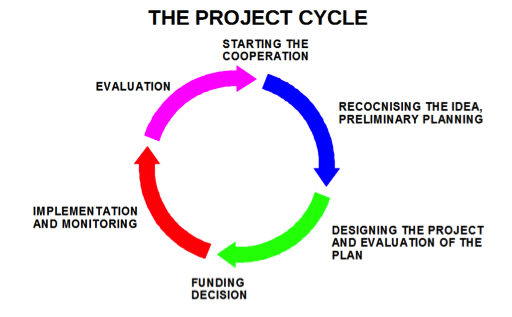
Funding cycle
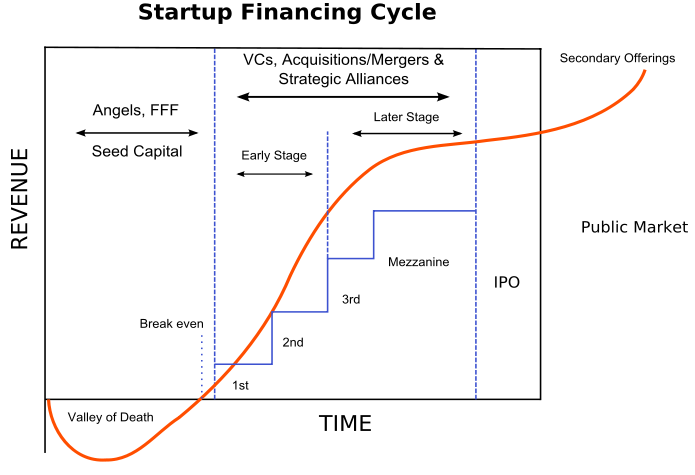
5.2 Infrastructure Construction Process
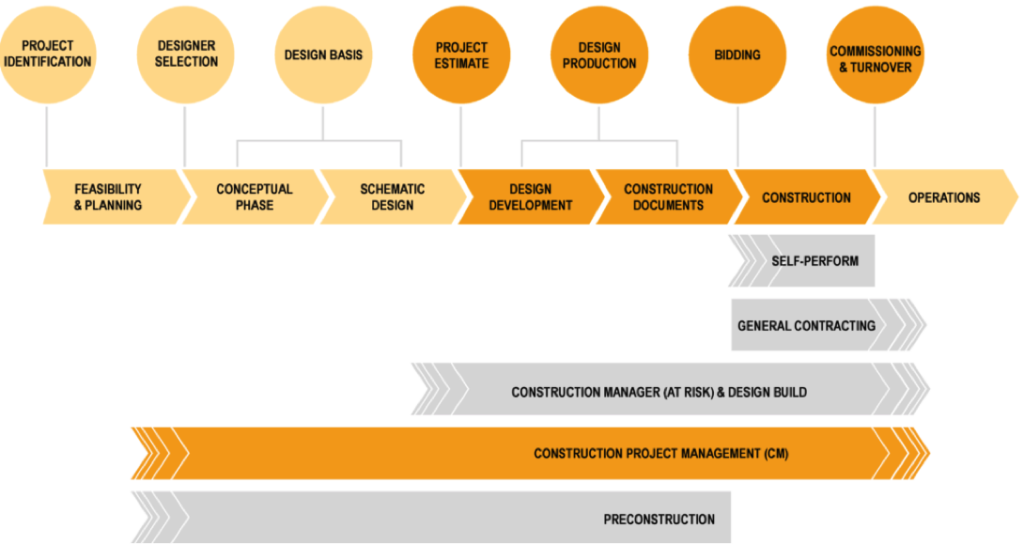
5.3 Infrastructure Life Cycle
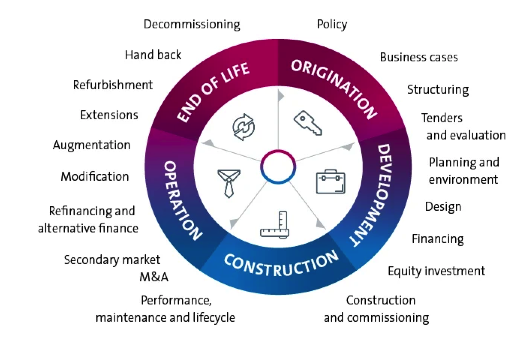
6.0 Financial Implications
6.1 Investment Segments
- Mass Transit Rail:
Balikpapan to Samarinda via new capital
150 km X US$47.7 million/km = US$7.2 billion
Kimanis to Kota Kinabalu
60 km X US$47.7 million/km = US$2.9 billion
- Highway: Pan Borneo Highway
Trans-Kalimantan section
4,000 km X US$7.7 million/km = US$30.8 billion
- Airport: Kimanis New Airport + LCCT
US$900 million + US$120 million = US$1.0 billion
- Seaport
6 ports X US$1.2 – US$7 billion/port = US$13.0 billion
- Water supply
30 million population X US$660/capita = US$19.8 billion
- Special Economic Zone (SEZ)
6 SEZs X US$2.0 billion/SEZ = US$12.0 billion
- Total investment
Total investment = US$86.7 billion
6.2 Production Cost
Projected production cost: (Budget = 90% of total investment cost)
Mass Transit Rail: US$9.09 billion
Highway: US$27.72 billion
Airports: US$0.9 billion
Seaports: US$11.7 billion
Water supply: US$17.82 billion
SEZ: US$10.8 billion
Total: US$78.03 billion
Case study
1. Infrastructure construction cost
- Location: The geographical location of the project can have a major impact on construction costs. Costs can vary between urban and rural areas, and even within cities. Remote or difficult-to-access locations may require additional expenses for transportation and logistics.
- Project Type: Different types of infrastructure projects, such as highways, airports, bridges, and railways, have unique cost considerations. The complexity and scale of the project can significantly affect costs.
- Government Regulations: Regulatory requirements, permits, and compliance standards set by local or national authorities can impact construction costs. Compliance with environmental regulations, safety standards, and zoning laws may add to project expenses.
- Economic Factors: Economic conditions, including inflation rates, currency exchange rates, and interest rates, can influence construction costs. Economic fluctuations can lead to price changes for labour and materials.
- Labour Costs: Labour costs, including wages, benefits, and availability of skilled workers, vary by region and can have a substantial impact on construction budgets.
- Materials Costs: The cost of construction materials, such as concrete, steel, asphalt, and timber, can fluctuate due to market conditions, supply and demand, and global factors like tariffs and trade policies.
- Infrastructure Accessibility: The ease of transporting materials and equipment to the construction site can affect costs. Inaccessible or remote areas may require additional investment in transportation infrastructure.
- Project Scale and Scope: The size and complexity of the project, as well as the quality and features required, can significantly impact costs. Larger and more complex projects typically have higher budgets.
- Technological Advancements: The use of advanced construction technologies, automation, and innovative building methods can influence construction costs. While some technologies may reduce costs, others may increase them due to initial investments.
- Contractual Agreements: The type of construction contract used, such as lump-sum, cost-plus, or design-build, can affect cost structures and risk allocation.
- Market Conditions: Local market conditions, including competition among contractors, subcontractor availability, and bidding processes, can influence construction costs.
- Environmental Factors: Projects in environmentally sensitive areas may require additional mitigation measures, impacting costs.
The following graphs provide a snapshot view of the cost comparison study in Australia.

6.3 Infrastructure Construction Revenue
Total revenue = US$86.7 billion
6.4 Financial Returns
Revenue – Cost = Income (Margin = 10% of total revenue)
US$86.7 – US$78.03 billion = US$8.67 billion
Mass Transit Rail: US$1.01 billion
Highway: US$3.08 billion
Airports: US$0.10 billion
Seaports: US$1.30 billion
Water supply: US$1.98 billion
SEZ: US$1.20 billion
Total: US$8.67 billion
Case study
1. A 2019 study by a professional service group on construction margin:
United Kingdom = 4.0% New Zealand = 7.0 % USA and Canada = 5.2% Mexico = 10.0% South America = 8.0% Europe, most markets = 5 - 6 % Amsterdam and Sweden = 10.0% Asia = 10.0% Middle East = 6.6% Source: Turner & Townsend 2019
2019 Financial Income of listed infrastructure construction companies.
Global
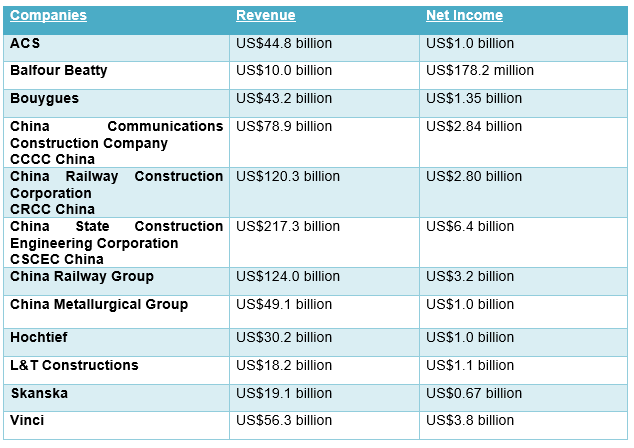
Local

6.5 Source of Funding
1. Strategic Investors:
- New Investor: These are individuals or entities with a focus on project leadership, business management, and financial expertise. They may invest in the project and play a key role in its management and direction.
- Financier: Infrastructure private equity firms and investor groups specialize in financing infrastructure projects. They provide the necessary capital for construction and development in exchange for returns on their investment.
- Infrastructure Group: International infrastructure construction groups or companies can be strategic investors in projects. They may bring their expertise in construction and project management to the table, along with financial contributions.
- Target Market: In your case, the target market for funding includes government agencies in Borneo Island, specifically in Brunei, Kalimantan, Sabah, and Sarawak. Government agencies often play a pivotal role in funding and overseeing large-scale infrastructure projects for public benefit.
2. Private Equities and Investors
3i Infrastructure Aberdeen Standard Investments Acadian Asset Management Actis African Infrastructure Investment Managers Allianz Capital Partners Amber Infrastructure Group AMP Capital Amundi Asset Management Ancala Partners Antin Infrastructure Partners APG Asset Management Aquila Capital Arcus Infrastructure Partners Ardian Infrastructure Arjun Infrastructure Partners AXA Investment Axium Infrastructure Aviva Investors Basalt Infrastructure Partners BlackRock Blackstone BNP Paribas Asset Management Bosera Asset Management Brookfield Asset Management Capital Dynamics Capital International Carlyle Group CBRE Global Investors CDPQ Charles Schwab Investment Management China Great Wall Asset Management China Investment Corp China Merchants Fund Management China Orient Asset Management China Structural Reform Fund Corporation CIBC Asset Management CIM Group Citibank Cohen & Steers Capital Management Copenhagen Infrastructure Partners Corfina Capital Cube Infrastructure Managers Daiwa Asset Management Dalmore Capital DEG Denham Capital DIF Capital Partners Dimensional Fund Advisors DNCA Finance DWS RREEF Infrastructure Edmond de Rothschild Group E Fund Management EQT Partners Equitix Investment Management FBR Capital Markets Ferrovial Fidelity Management & Research Finnfund First Sentier Investors First Trust Advisors Foresight Group Franklin Templeton Sealand Fund Management GAM Investment Management GCM Grosvenor GF Fund Management GIC Glennmont Partners Global Infrastructure Partners GMO Investment and Asset Management Golding Capital Partners Goldman Sachs Gravis Capital Management Greencoat Capital Gresham House Handelsbanken Fonder HDFC Asset Management Hermes Infrastructure HIG Capital HSBC Global Asset Management ICBC Credit Suisse Asset Management ICICI Prudential Asset Management IFM Investors Impax Asset Management Indo Premier Securities (Investment Management) Indonesia Infrastructure Finance Infranity Infranode Infrared Capital Partners InfraVia Capital Partners ING Infrastructure Finance Invesco Advisers I Squared Capital Janus Henderson Asset Management Keppel Capital Holdings KGAL Investment Management KKR Kotak Mahindra Asset Management La Banque Postale Asset Management Lazard Asset Management Legal and General Investment Management Lion Global Investors Lyxor International Asset Management M&G Investment Management Mackenzie Financial Corp Macquarie Infrastructure and Real Assets Manulife Infrastructure Equity Fund Maple-Brown Abbott Marguerite Matthews International Capital Management McKinley Capital Management MEAG Meridiam Infrastructure MetLife Investment Management Mirova MNC Asset Management Morgan Stanley Investment Management MPC Capital Natixis Investment Managers Nikko Asset Management Asia Ninety One Nippon Life India Asset Management Nissay Asset Management Nomura Asset Management Nordea Investment Management Norges Bank Investment Management NOVA Infrastructure Nuveen Nykredit Asset Management Oaktree Capital Management Palico Pantheon Infrastructure Partners Group Pathway Capital Management Patrizia Pheim Asset Management Plenary Group Principal Asset Management Prospera Asset Management Qatar Holding Queensland Investment Corporation Regenerate Asset Management Rivage Investment Robeco Institutional Asset Management Santander Asset Management Sarana Multi Infrastructure (SMI) SBI Funds Management Schroders Sequoia Investment Management Company Société Générale Gestion SPF Beheer Stonepeak Infrastructure Partners Sumitomo Mitsui DS Asset Management Swedbank Robur Fonder SWEN Capital Partners Swiss Life Asset Managers Taspen Threadmark UBS Asset Management Union Investment Vanguard Group Vantage Infrastructure Vauban Infrastructure Partners Whitehelm Capital William Blair Investment Management Yielco Investments
3. Consultants, development and funding managers associated the infrastructure industries:
AIM Infrastructure
Angkasa Consulting Services
Asian Development Bank
Asian Infrastructure Investment Bank
BCG (Boston Consulting Group)
Bentley
Campbell Lutyens
CDC Group
Egbers Investment Partners
Ernst & Young
Evercore Partners
Global Infrastructure Hub
IFC (International Finance Corporation)
IJ Global
Indonesia Infrastructure Guarantee Fund (IIGF)
Indonesia Investment Authority (INA)
Indonesia Investments
IMF (International Monetary Fund)
Infrastructure Asia
Infrastructure Investor
Invest Europe
KPMG
Long Term Infrastructure Investors Association (LTIIA)
McKinsey & Company
Preqin
Private Equity International (PEI)
PwC (PricewaterhouseCoopers)
Rothschild & Co
Sera Global
World Bank
6.6 Additional Revenue
The major revenue sources for infrastructure projects typically include public funds and user-pay charges. These sources can generate significant revenue for infrastructure development. Here are some additional revenue opportunities and strategies:
- Ownership of Assets: Infrastructure projects often involve the creation of assets such as transportation networks, utilities, and public facilities. Owning these assets provides the opportunity to generate long-term and stable income through various means, such as leasing, tolls, or usage fees.
- Partnerships: Collaborating with asset holders or other stakeholders can be a lucrative revenue strategy. Public-Private Partnerships (PPPs) are a common approach where private entities partner with government agencies to develop, operate, and maintain infrastructure assets. This partnership often involves revenue-sharing arrangements.
- Property Development: As mentioned, property development can be a significant source of revenue, especially in projects involving land acquisition and development. The “Rail plus Property Model” in Hong Kong is a prime example, where the construction of transportation infrastructure is coupled with property development opportunities along transit routes. Revenue is generated through property sales, rentals, and related services.
- User Charges: Besides initial user-pay charges, ongoing user fees, tolls, or usage charges can provide a steady stream of revenue for infrastructure projects, especially in sectors like transportation and utilities.
- Government Funding: Public funds, including government grants and subsidies, are often used to finance infrastructure projects. These funds can cover a portion of the project costs, reducing the financial burden on private investors or taxpayers.
- Debt Financing: Infrastructure projects can secure financing through loans or bonds, with the expectation that revenue generated from the project will be used to repay the debt over time.
- External Investment: Attracting external investors, including international investment groups, sovereign wealth funds, and institutional investors, can provide a significant source of funding for large-scale infrastructure projects.
- Operations and Maintenance Contracts: Infrastructure projects may involve long-term contracts for operations and maintenance services, generating ongoing revenue for the entities responsible for these activities.
- Value Capture Mechanisms: Governments can implement value capture mechanisms to recover a portion of the increased land or property values resulting from infrastructure development.
- Innovative Financing Models: Some regions explore innovative financing models, such as green bonds or public bonds, to fund sustainable infrastructure projects while attracting environmentally conscious investors.
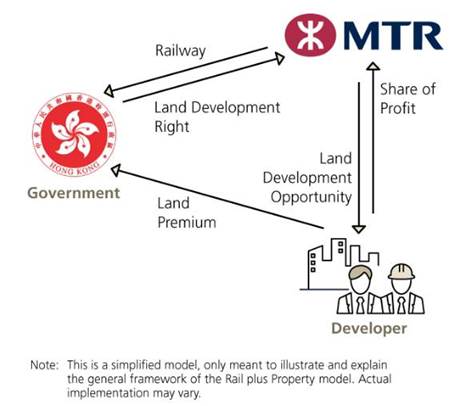
Source: MTR Hong Kong 2014
7.0 Management Team
Global top leaders are presented here, as a tribute to honour their vision, successful mission, and contribution to the industry.
7.1 Key Management Team
- Mentors: Visionary pioneers and industry leaders who provide guidance and inspiration.
- Coaches: Mission-oriented industry experts offering practical solutions.
- Partners:
- A project leadership group with experience in the specific segment and international exposure to the infrastructure construction industry.
- A reputable investment manager with sources of funding in the Asia Pacific infrastructure industry.
- Target market groups comprising government agencies.
- A credible local infrastructure partner with procurement capabilities, local network, sound financial status and solid support from the government.
In the infrastructure industry, several global leaders have made significant contributions, shaping its growth and success. Here is a list of some of these remarkable individuals, honoured for their vision and dedication:
- Pierre Anjolras
- Stephen Beatty
- Martin Bouygues
- Chen Wenjian
- Cyril Cabanes
- Christopher Heathcote
- Florentino Pérez
- Kym Williams
These are just a few of the outstanding professionals and captains of the industry. The readers are encouraged to explore further and conduct their research to learn more about the management teams in this dynamic field.
7.2 Key Management Team Model
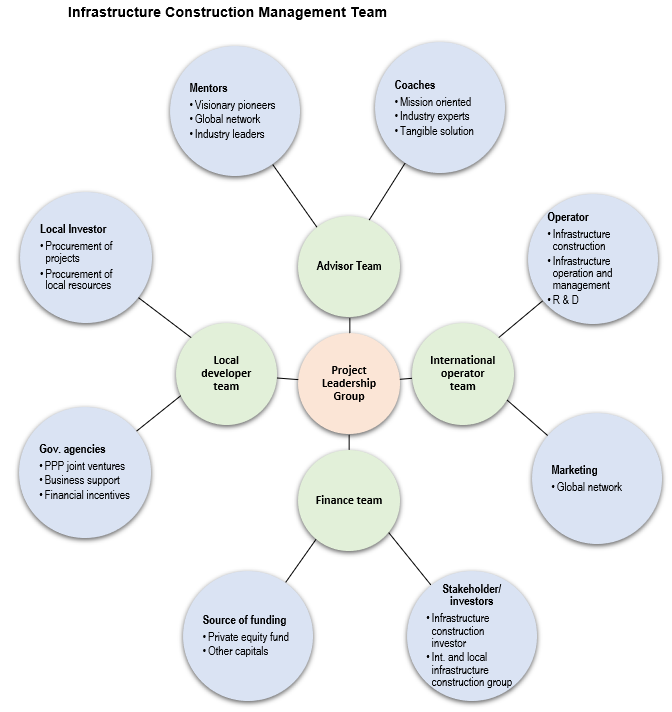
8.0 Unique Business Model
8.1 Successful Track Record
- Team: The team consists of experienced and successful international key players in the infrastructure construction industry. This wealth of experience and expertise is crucial for the successful execution of infrastructure projects.
- PPP Model: The Public-Private Partnership (PPP) model has a proven track record in international infrastructure projects. PPPs involve collaboration between public and private sectors, which can help ensure efficient project delivery and management.
8.2 Entry Model
- JV Entity: The entry model involves forming a joint venture (JV) entity that includes international consortiums, local contractors, and government agencies. This collaborative approach enhances project expertise, shares risks and responsibilities, and leverages local knowledge and resources.
8.3 Unique Business Model
- Goals: Ensuring successful track records of global infrastructure companies are essential to guarantee project goals in terms of timing, quality, and financial outcomes. Demonstrated success builds trust among stakeholders.
- Return: Focusing on the target market within specific infrastructure sectors ensures that financial goals are met. This market-driven approach enhances the likelihood of achieving expected returns on investment.
- Growth: The business model includes plans for expanding beyond the initial projects in Borneo. This growth strategy can lead to the development of a broader portfolio of infrastructure projects, further enhancing revenue and impact.
- Support: Collaborating with local government agencies provides solid support and alignment with regional development goals. Government support can facilitate permitting, regulatory compliance, and access to necessary resources.
- Community: The model emphasizes the positive impact on local communities through employment opportunities and on-the-job training programs. This community-focused approach not only benefits the workforce but also fosters goodwill and support for the projects.
9.0 Key Success Factors & Risk Mitigation
9.1 Key Success Factors
- Experience: Success in attracting investment in the infrastructure construction industry relies on a proven track record in construction management, viable financial returns, government support, economic growth, and business flexibility.
- Hands-On Approach: PPP stakeholders will actively participate in every stage of the infrastructure project, from pre-planning to funding, procurement, scope definition, and goal alignment.
9.2 Risks
- Political: Political instability and changes in regulatory policies can be a concern for foreign investors.
- Instability: A low-cost competitive environment and a lack of project continuity can discourage foreign construction companies that value stability and consistent project quality.
- Productivity: Challenges related to local labour force productivity, advanced technology adoption, management conflicts stemming from diverse cultures, construction equipment availability, and timely cash flow are identified risks.
9.3 Risk Mitigation
- Bankability: Government policies will be established to reinforce the bankability of projects, and repayment to the government will be made through infrastructure assets.
- Partnership: Collaboration in procurement, including innovative contracting approaches, will enhance financial viability and project quality.
- Training: Skill assessment and on-the-job training programs will be implemented to develop construction expertise. Effective cross-cultural communication will promote mutual respect, and funding commitments will ensure smooth cash flow during construction.
- Competitive: Embracing Environmental, Social, and Governance (ESG) principles and digitalization will improve corporate governance and technical performance.
10.0 Exit Strategy
- Forms of Exit: The completion of projects represents one form of exit. This occurs when asset owners take over the completed projects, signalling a successful transition from construction to operation and ownership.